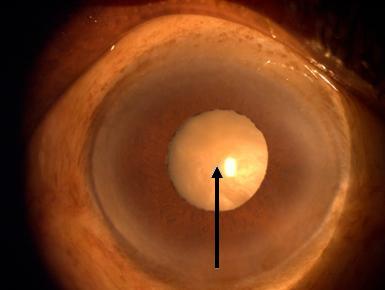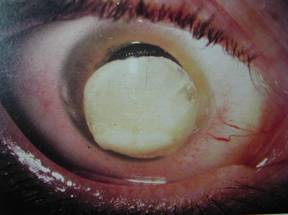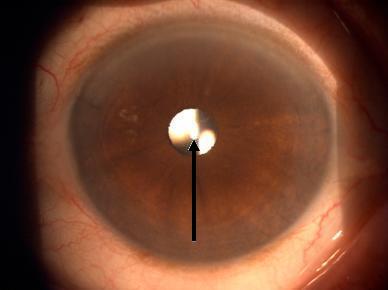A cataract is a clouding of the normally clear lens of the eye. It can be compared to a window that is partly covered with dirt. Cataract development is a normal process of aging, but cataracts also develop from eye injuries, certain diseases or medications. Cataract is a major cause of reversible blindness.
A cataract needs to be removed only when reduce vision interferes with daily activities, such as driving, reading, or watching TV. In most cases, delaying cataract surgery will not cause long-term damage to your eye or make the surgery more difficult.
Photograph showing dense cataract

Mature (dense) cataract (opaque lens behind the pupil)
Photograph showing complicated cataract

Dislocated mature cataract (Displaced cataractous lens in front,following injury)
Photograph showing eye after cataract surgery

Intraocular lens (IOL), behind the pupil
Signs & symptoms
Common symptoms of cataract include:
- Painless progressive blurring of vision
- Glare (car headlights, lamp or sunlight may appear too bright)
- Frequent eyeglass prescription changes
- Double vision in one eye
- Poor night vision
- Colors seem faded
Complications
As mentioned above, an immature cataract needs to be removed only when daily activities are affected. However, a mature cataract needs to be operated early before complication such as lens induced glaucoma or lens induced inflammation occurred, which may lead to irreversible blindness.
Treatment
A cataract may not require surgery if vision is only slightly affected. Simply changing eye-glasses prescription may help to improve the vision for a while. There are no medications, eye-drops, exercises or glasses that will cause cataracts to disappear once they have formed. Surgery is the only way to remove a cataract.
In cataract surgery, the cloudy lens is removed from the eye through a surgical incision. In most cases, the natural lens is replaced with a permanent intraocular lens (IOL) implant. .
Prevention
Most cataracts are age-related. However, cataracts can also be caused by:
- Congenital factors,
- Conditions such as diabetes,
- Environmental factors such as eye trauma,
- Medicines such as prednisone (steroid), or
- Poor nutrition.
At this time, it is not known how to protect against cataracts, however there are few good practices that you can follow.
GOOD PRACTICES that might help to prevent or delay the progression of cataract:
- Well balanced diet
- Regular exercise (helps in controlling blood sugar)
- Good control of Diabetes
- BE CAREFUL and be sure of the contents when taking traditional medication (they might contain STEROIDs)
- Protect your eye from UV light by using sunglasses with UV BLOCK.
- Protect your eye from injuries by using eye protective goggles when doing dangerous activities (hammering, handling chemicals, etc.)
| Last reviewed | : | 23 August 2019 |
| Writer | : | Dr. Joseph Vijaya Alagaratnam |
| Reviewer | : | Dr. Rosniza bt. Ab. Razak |







